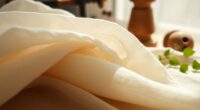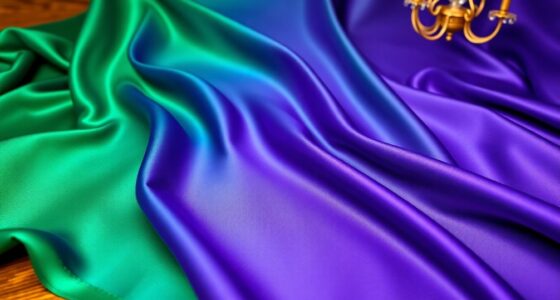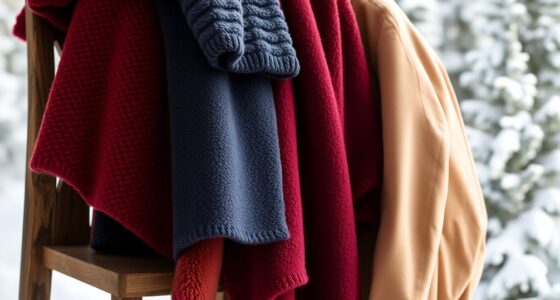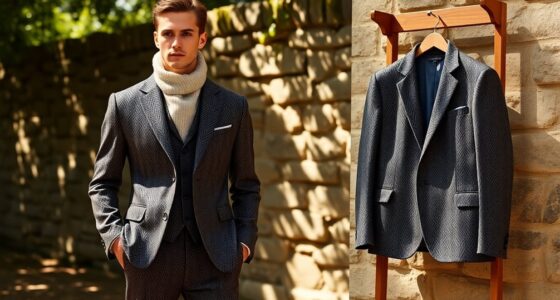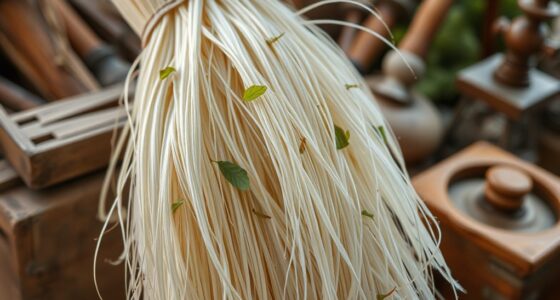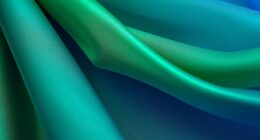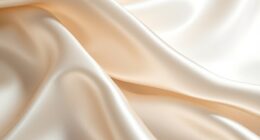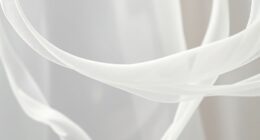Modal fabric is your go-to choice for breathable, eco-friendly clothing. Made from beech tree pulp, it feels luxurious while requiring 10-20 times less water than cotton. Its exceptional moisture-wicking properties keep you comfortable, and it's durable enough to resist wear and tear. Plus, modal's production promotes sustainability through responsible sourcing and recycling practices. Want to discover more about its benefits and blends that enhance comfort? There's plenty more to uncover about this versatile fabric.
Key Takeaways
- Modal fabric, made from beech tree pulp, offers exceptional breathability and moisture-wicking properties, making it ideal for comfortable clothing.
- It is eco-friendly, requiring significantly less water for production compared to cotton, thus conserving vital resources.
- The closed-loop manufacturing process minimizes environmental impact by recycling water and chemicals used during production.
- Modal is durable and resistant to shrinkage, fading, and pilling, ensuring long-lasting garment quality while supporting sustainable fashion.
- Ethical sourcing of modal supports sustainable forest management, reducing deforestation and promoting responsible consumption choices.
Understanding Modal Fabric: A Luxurious Alternative
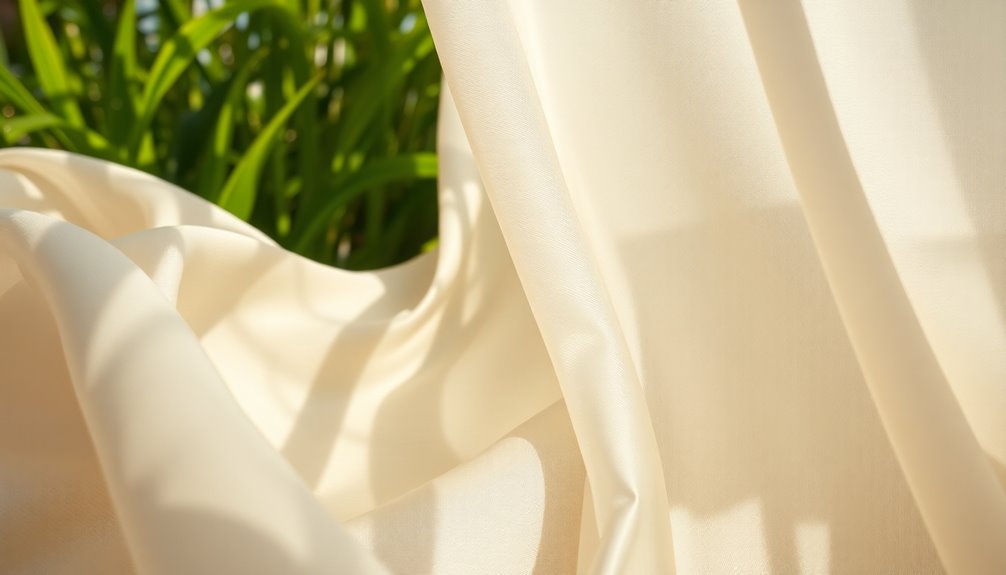
When it comes to luxurious fabrics, modal stands out as a top choice. Made from beech tree pulp, it boasts an ultra-soft, silky texture that rivals traditional fabrics like cotton and silk.
You'll appreciate its exceptional breathability and moisture-wicking properties, which help keep you comfortable by efficiently absorbing and releasing moisture.
Plus, modal fabric is eco-friendly, requiring 50% less water for tree growth compared to cotton, making it a sustainable option for your wardrobe.
Its durability guarantees that it resists shrinkage, fading, and pilling, so your garments stay in excellent condition.
With its biodegradable nature and sourcing from sustainably managed forests, modal aligns perfectly with your desire for environmentally responsible clothing options.
The Manufacturing Process of Modal Fabric

Modal fabric's luxurious qualities come from a meticulous manufacturing process that transforms beech tree pulp into soft, breathable textiles.
First, beech trees are harvested and chipped into small pieces to extract cellulose fibers. Then, the cellulose undergoes treatment with sodium hydroxide and carbon disulfide, converting it into sodium cellulose xanthate—a soluble form.
This solution is spun through a spinneret, forming continuous fibers. Afterward, these fibers are washed and dried, resulting in the final modal fabric.
This process uses a closed-loop system that recycles water and chemicals, greatly reducing environmental impact. Plus, modal requires 10-20 times less water than cotton, making it a more eco-friendly fabric choice.
You can feel good wearing clothes made from beech!
Sustainability in Modal Production: What You Need to Know

When it comes to sustainability, Modal fabric stands out due to its impressive water usage efficiency, requiring considerably less water than cotton.
You'll also appreciate that the beech trees used in its production come from renewable sources, ensuring ethical sourcing practices.
However, it's crucial to evaluate the manufacturer's methods, as they can impact the overall sustainability of the fabric.
Water Usage Efficiency
Although many textiles strain our water resources, modal fabric stands out as a remarkably water-efficient choice for sustainable clothing. It requires about 10-20 times less water to grow compared to cotton, making it a smart option for eco-conscious consumers like you.
The beech trees from which modal is derived consume considerably less water, reducing the overall water consumption in the textile industry. Plus, modal's closed-loop production system recycles water, enhancing water usage efficiency while minimizing waste.
The responsibly sourced wood comes from managed forests, further supporting sustainability. Not only does this process conserve water, but modal's exceptional moisture-wicking properties guarantee your garments remain breathable and comfortable. Additionally, the benefits of sustainable resource recovery in production processes contribute to overall environmental conservation.
Choosing modal means you're making a difference for the planet.
Ethical Sourcing Practices
Sourcing modal fabric ethically is essential for ensuring that your clothing choices support sustainable practices.
Look for brands that use responsibly managed beech tree forests, where wood is harvested without harming ecosystems. Companies like Lenzing AG set a standard in ethical sourcing by recycling all solvents in their production process, promoting a circular economy.
Remember, modal requires considerably less water than cotton, making it a more sustainable choice, but the sustainability of the final product hinges on manufacturers' practices regarding wood sourcing and chemical usage. Additionally, using eco-friendly materials in production processes can significantly reduce environmental impact.
Not all modal fabric is created equally, so do your research. By supporting brands committed to sustainably sourced materials, you help foster responsible production practices in the modal industry, reducing textile waste and environmental degradation.
Modal vs. Viscose Rayon: Key Differences

When comparing modal and viscose rayon, you'll notice key differences in their raw materials and production processes.
Modal, made exclusively from beech trees, stands out for its energy efficiency and lower environmental impact.
In contrast, viscose rayon's broader sourcing can lead to greater resource consumption and potential pollutants during manufacturing.
Source of Raw Materials
While both modal and viscose rayon are derived from cellulose, their raw materials differ considerably. Modal is exclusively sourced from the pulp of beech trees, which are cultivated in sustainably managed forests. In contrast, viscose rayon can come from various tree types, leading to inconsistencies in sourcing practices. Additionally, modal production requires much less water—up to 10-20 times less than cotton and viscose rayon—making it a more sustainable choice.
| Feature | Modal |
|---|---|
| Raw Material Source | Pulp of beech trees |
| Water Requirement | Much less water |
| Forest Management | Sustainably sourced |
| Environmental Impact | Lower deforestation |
| Softness & Durability | Superior |
Production Process Efficiency
In comparing the production process efficiency of modal and viscose rayon, it's clear that modal stands out as the more sustainable option.
Modal is made exclusively from beech trees, which grow faster and need less water than the various trees used for viscose rayon. This alone makes modal better for our planet.
Additionally, modal production uses a closed-loop system that recycles water and minimizes waste, something viscose rayon production typically lacks. This results in approximately 30% more energy efficiency and a lower carbon footprint.
Furthermore, the chemical processes in modal production emit fewer harmful substances, creating a cleaner manufacturing process. Moreover, excessive butter consumption can lead to weight gain due to its high-calorie content, highlighting the importance of mindful consumption in all dietary choices.
All these factors contribute to modal fabric being a high-quality choice for environmentally conscious consumers.
Environmental Impact Comparison
Although both modal and viscose rayon are derived from wood pulp, their environmental impacts differ greatly.
Here's a quick comparison to help you understand the differences:
- Sourcing: Modal rayon comes exclusively from beech trees, promoting sustainable practices, while viscose can be made from various tree types.
- Water Usage: Modal requires 10-20 times less water than cotton, making it more eco-friendly compared to viscose rayon.
- Energy Efficiency: The manufacturing process for modal is about 30% more energy-efficient, reducing its carbon footprint substantially.
- Production Emissions: Modal fibers emit fewer harmful substances, resulting in a cleaner production process and overall lower environmental impact.
Moreover, choosing modal not only benefits your wardrobe but also supports a healthier planet, contributing to asset diversification in sustainable fashion choices.
Benefits of Choosing Modal Fabric for Your Wardrobe
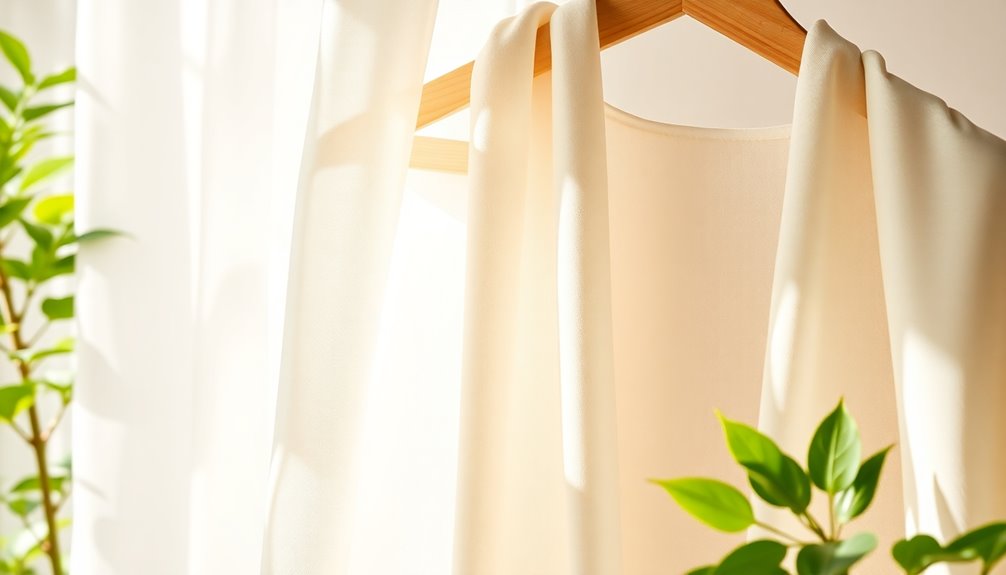
Choosing modal fabric for your wardrobe not only elevates your style but also enhances your comfort. This luxurious material boasts a silky texture, offering a high-end feel that's more affordable than silk.
Modal is highly absorbent and outperforms cotton in moisture-wicking, making it perfect for both activewear and everyday clothing. Its breathable weave promotes excellent air circulation, keeping you cool and comfy throughout the day.
Plus, modal is made from sustainably sourced beech trees, requiring far less water to grow, making it an eco-friendly choice.
With its durability and resistance to fading, wrinkling, and shrinking, modal garments tend to last longer, providing better value over time.
Embrace modal and enjoy a stylish, comfortable, and sustainable wardrobe!
Disadvantages of Modal Fabric: What to Consider

While modal fabric offers many advantages, it's important to reflect on its potential drawbacks before making a purchase.
Here are some key disadvantages of modal fabric to take into account:
- Cost: Modal can be pricier than cotton due to its complex production processes.
- Stretching: When wet, modal tends to stretch, which may affect the garment's shape and fit over time.
- Allergic Reactions: Some individuals may experience allergic reactions to modal fabric because of its wood pulp content, making it unsuitable for certain skin types.
- Durability: Although modal is durable, it's less resistant to damage from sharp objects, which can lead to tears or snags.
Taking these factors into account will help you make a more informed decision about your clothing choices.
Exploring Popular Modal Blends for Enhanced Comfort
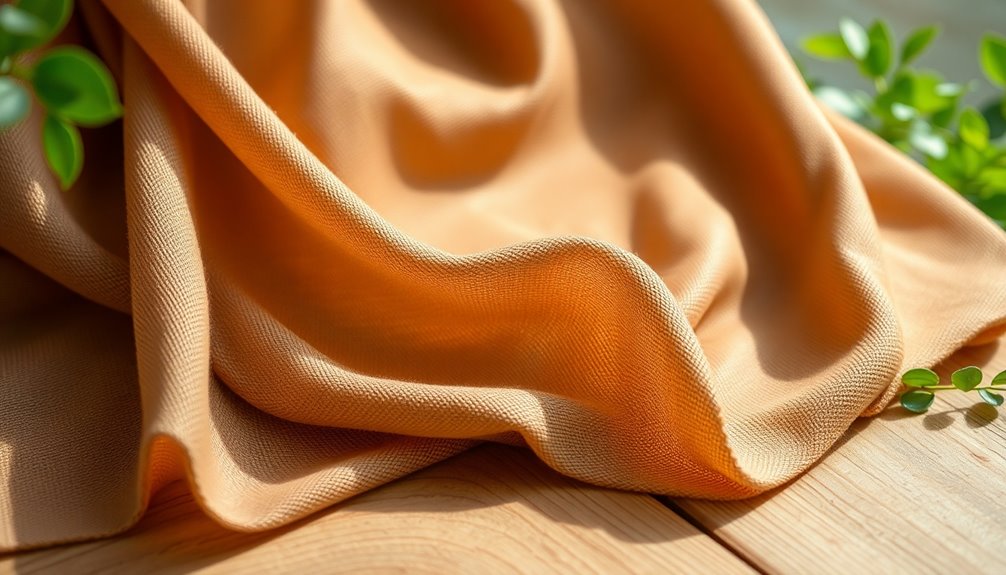
When you explore modal blends, you'll discover a world of comfort that enhances your wardrobe. Blending modal with cotton gives you an ultra-soft, breathable fabric that feels great against your skin while ensuring durability.
If you're into activewear, combining modal with spandex creates a stretchy, flexible material that allows for easy movement and moisture management. For everyday wear, a modal-polyester blend offers resilience and reduced wrinkling, making maintenance a breeze.
If loungewear is your focus, look for blends with bamboo fibers for a soft, eco-friendly, and absorbent option. Many garments also mix modal and rayon, balancing luxury with practicality, providing that silky feel while keeping breathability intact.
These blends elevate your comfort and style effortlessly.
The Importance of Ethical Sourcing in Modal Production
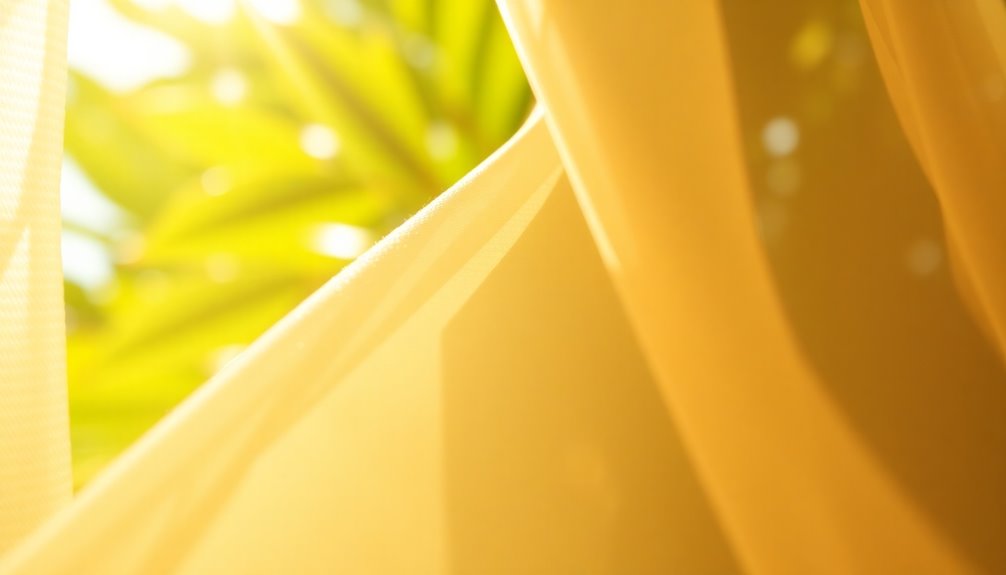
As you explore the world of modal fabric, understanding the importance of ethical sourcing becomes essential.
Ethical sourcing guarantees that the wood pulp used in modal production comes from sustainably managed forests, primarily beech trees. This practice not only conserves water but also minimizes environmental impact.
Here are four reasons why you should care about ethical sourcing in modal production:
- Sustainable Forest Management: Supports forests that thrive without depleting resources.
- Environmental Protection: Reduces the risk of deforestation and protects endangered ecosystems.
- Transparency: Encourages brands to disclose their sourcing methods, promoting accountability.
- Consumer Demand: Aligns with your desire for responsible and eco-friendly fashion choices.
Consumer Tips for Identifying Sustainable Modal Brands
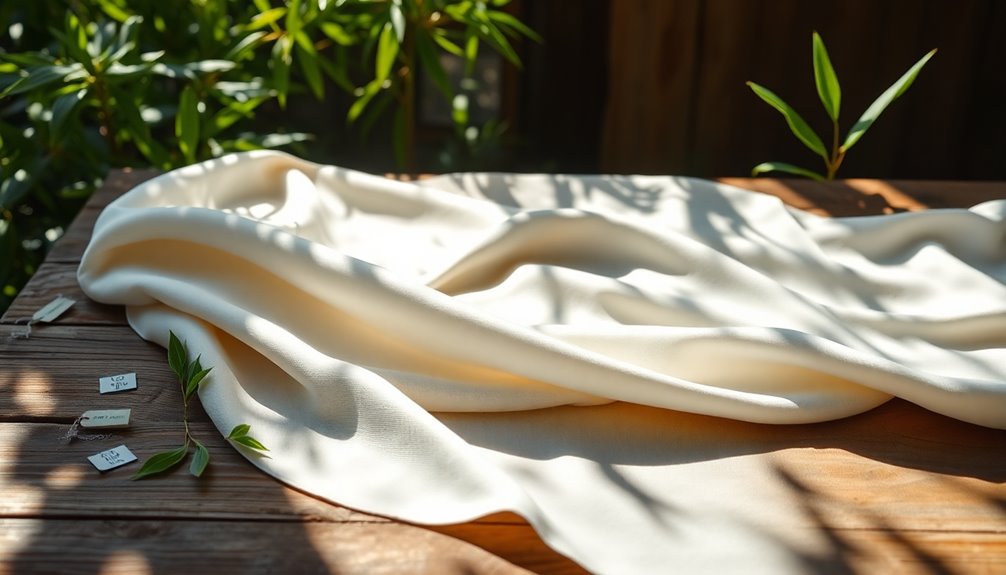
How can you spot sustainable modal brands in a sea of options? Start by looking for TENCEL Modal®, made from sustainably sourced beech trees and produced using eco-friendly methods that recycle solvents.
Investigate whether the brand sources wood from responsibly managed forests to prevent deforestation. Certifications from reputable organizations can also indicate a commitment to sustainable textiles and ethical manufacturing.
Pay attention to their water usage; modal fabric typically needs 10-20 times less water than cotton, an essential factor in sustainability.
Finally, research customer reviews and the brand's reputation. Not all modal is created equal, so choose brands that prioritize eco-friendly practices and transparency in their supply chain to guarantee you're making a responsible choice. Additionally, consider brands that utilize certifications from reputable organizations to validate their commitment to sustainability.
The Future of Fashion: Embracing Modal Fabric
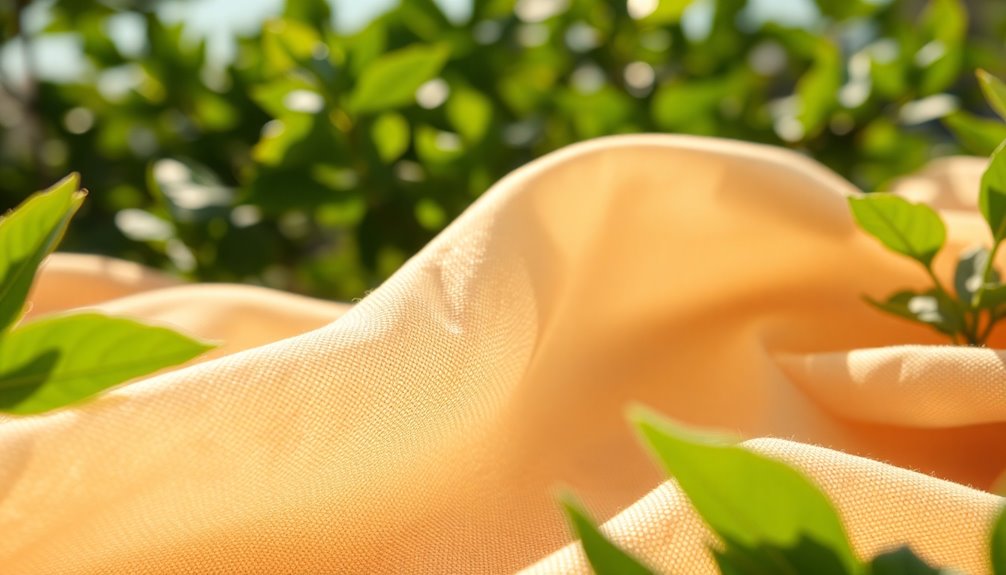
As you explore the future of fashion, modal fabric stands out as a key player in the sustainable fashion revolution.
With its silky texture and breathability, it perfectly blends comfort and style, making it a favorite for everyday wear.
Sustainable Fashion Revolution
The sustainable fashion revolution is gaining momentum, and embracing Modal fabric is a game-changer for eco-conscious brands.
This plant-based material, made from the pulp of beech trees, offers a greener alternative to traditional textiles.
Here are four reasons to evaluate Modal:
- Water Efficiency: Modal requires 50% less water than cotton.
- Closed-Loop Production: Its manufacturing recycles water and minimizes waste.
- Biodegradable: Modal decomposes naturally, leaving no environmental harm.
- Softness and Breathability: It provides exceptional comfort without sacrificing sustainability.
Additionally, the use of Modal aligns with sustainable practices that promote eco-friendly production methods and reduce harmful environmental impacts.
Comfort Meets Style
While many fabrics prioritize either comfort or style, Modal effortlessly combines both, making it a standout choice in the modern wardrobe.
Its luxurious, silky texture feels incredible against your skin, ensuring you stay super soft and comfortable throughout the day.
Modal's moisture-wicking properties outshine traditional cotton, keeping you dry, making it perfect for active lifestyles.
When blended with cotton and spandex, it enhances stretchiness and flexibility, ideal for both casual and athletic wear.
Plus, its elegant drape enhances your outfits, offering a chic alternative to synthetic materials.
With a focus on sustainability, Modal's eco-friendly production aligns with your desire for stylish yet responsible fashion choices.
Embrace Modal, and experience the perfect balance of comfort and style. Additionally, its ability to regulate emotional and physical wellbeing makes it an excellent choice for those seeking comfort in their clothing.
Frequently Asked Questions
What Is the Downside of Modal Fabric?
The downside of modal fabric lies in its production and performance. It can be pricier than cotton, which might stretch your budget.
The manufacturing process uses hazardous chemicals that pose environmental risks. When wet, modal tends to stretch, changing the garment's shape over time.
While it's absorbent, it doesn't hold body heat, making it unsuitable for colder weather. Plus, some people may have allergic reactions due to its wood pulp content, limiting its wearability.
Is Modal an Environmentally Friendly Fabric?
When it comes to eco-friendly fabrics, Modal definitely holds its own.
It's made from beech trees, which need much less water than cotton, making it a greener choice.
Plus, its closed-loop manufacturing process recycles water and minimizes waste, which is a win-win for the planet.
Just keep in mind that not all Modal is created equal; always source from ethical brands to guarantee you're making a truly sustainable choice.
Is Modal Fabric Breathable?
Yes, modal fabric is breathable.
You'll appreciate its excellent air circulation, which keeps you cool in warm conditions. Its lightweight nature gives you a soft, airy feel that's comfortable against your skin.
Plus, modal's moisture-wicking properties work wonders; it absorbs sweat and helps it evaporate quickly, keeping you dry.
This breathability also means less odor, making it a perfect choice for your activewear and casual outfits, especially in the heat.
Does Modal Fabric Release Microplastics?
Modal fabric doesn't release microplastics, which is one of its significant advantages.
Since it's made from natural cellulose fibers, you won't have to worry about tiny plastic particles polluting the ocean during washing.
Unlike synthetic fabrics, modal decomposes naturally without harming the environment.
Conclusion
In a world where comfort meets conscience, embracing modal fabric is like wrapping yourself in a gentle hug from nature. Its breathability and eco-friendly charm offer you a stylish way to tread lightly on the planet. By choosing modal, you're not just elevating your wardrobe; you're also supporting sustainable practices that make a difference. So, why not indulge in the luxurious feel of modal while contributing to a greener future? Your closet—and the Earth—will thank you!

